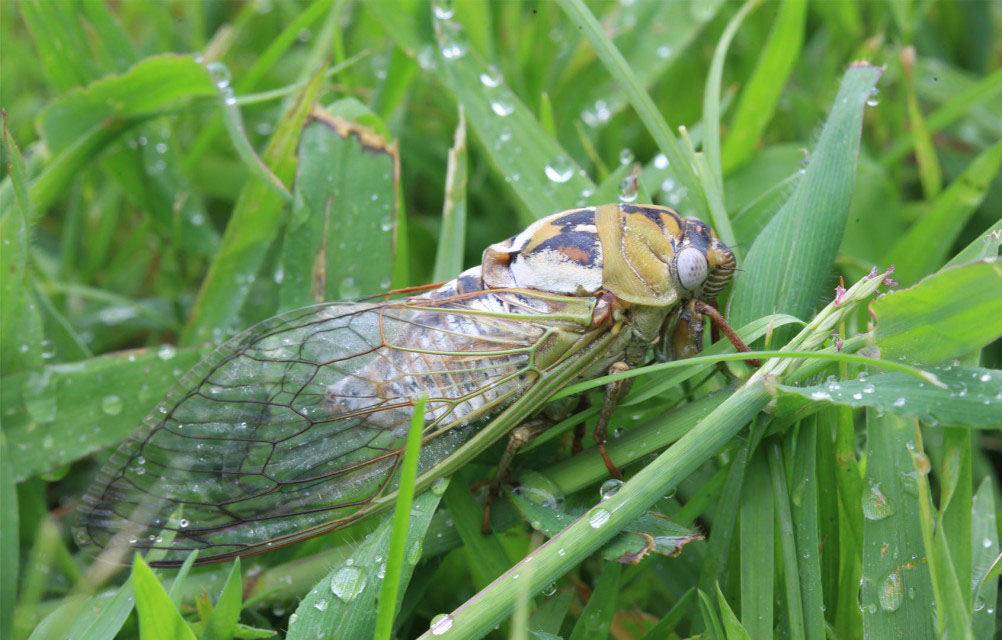
By Julie Geiser
This call of the male cicada is unmistakable this time of year, when cicadas or more commonly called locusts emerge from their underground homes to breed.
Starting in mid-summer and continuing for a couple months the songs of the cicadas’ can be heard for miles.
There are several species of cicadas in Nebraska, but the most common cicada near my hometown of North Platte is the Dog Day or Annual Cicada. These cicadas make their appearance during the “Dog Days” of late summer when we see the fully developed nymphs burrowing out of the ground mostly at night, dusk or dawn, leaving a one-half inch hole behind them. The nymphs climb onto tree trunks, low plants or other objects where the adult cicadas emerge from this last nymphal stage.
Starting through a crack along the back of their shell, the adult slowly emerges, leaving the light brown cast skin or shell behind – the remnant that we see left on trees. The newly emerged adults inflate their wings to dry. The drying process takes some time, as they dry their light green body and wings darken and harden, then the adults climb or fly to find food – feeding upon the sap of leaves and twigs.
Males of the dog-day cicadas produce the loud buzzing song that we hear – this sound is used to attract the female cicada, which does not produce noise.
On the underside of the abdomen at the front are two stiff membranes called tymbals. If you turn a male on its back you will see two shield-like structures just under the hind legs. The tymbals are underneath these structures. The male cicada has a special muscle attached to them and by rapidly contracting and relaxing the muscle – up to 400 times per second – their song is made. When the cicada’s muscle gets tired he will stop to rest. This is what happens when you hear the buzz of a cicada sputter to a halt. Each species of cicada has a distinct song it produces.
The cicada chorus serves to attract females, but the sound also advertises the males’ presence to predators. Predators like birds including raptors and squirrels love cicadas. The cicada’s only defense is their lack of bright colors, which provides camouflage and their ability to fly from danger. By emerging in great numbers over a short period of time, they cicada population succeeds by overwhelming predators with their numbers – ensuring that there is a breeding population to carry on the circle of cicada life.
I happened upon a cicada covered tree at Lake Maloney State Recreation Area (SRA) – this magnificent cottonwood tree housed hundreds of cicadas by the looks of the shells on the tree. Perched in this tree was a crafty squirrel that had found a seasonal smorgasbord to fill its stomach with. The squirrel watched me from each side of the tree as I tried to capture it grabbing up a newly emerged cicada. I wasn’t quite fast enough to catch the grab, but from the looks of things cicadas must be quite tasty.
Mating occurs in the trees and the females insert their eggs into the small twigs of trees and shrubs – these eggs are the start of the next generation of cicadas. The adults have a short life span of five to six weeks.
In six to seven weeks, small nymphs hatch from the eggs and drop to the ground. They burrow into the soil using their strong front legs to dig with. As they molt through several growth stages called instars, the nymphs may burrow several feet underground where they develop by feeding upon sap from the roots of various trees. Development of the Dog Day or Annual Cicada takes two to five years before reaching their full-grown nymph stage before they climb out of their underground homes to start the cycle over again. Other species of cicadas can take up to 17 years before they develop and climb above ground.
The call of the cicada is one I look forward to every summer – it is a reminder of the cycle of life that we all witness from year to year and the hint that cooler weather will soon be on its way.
